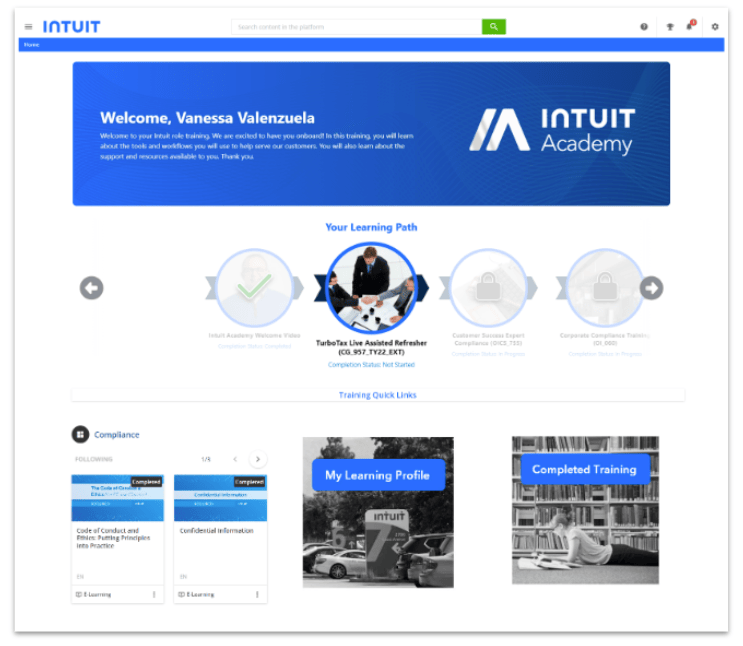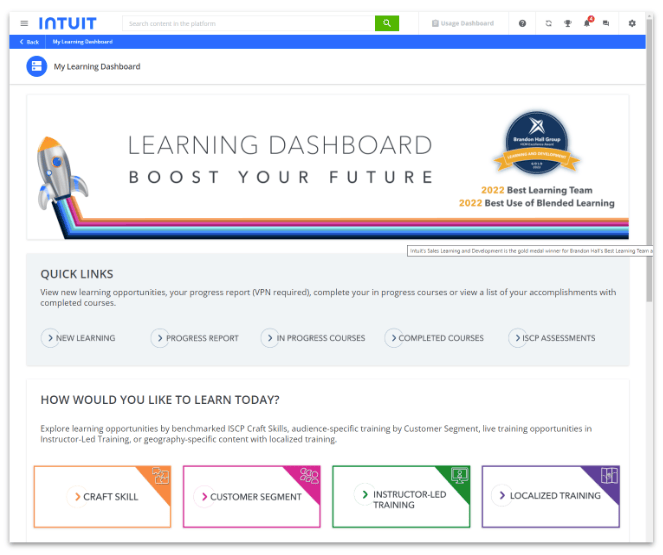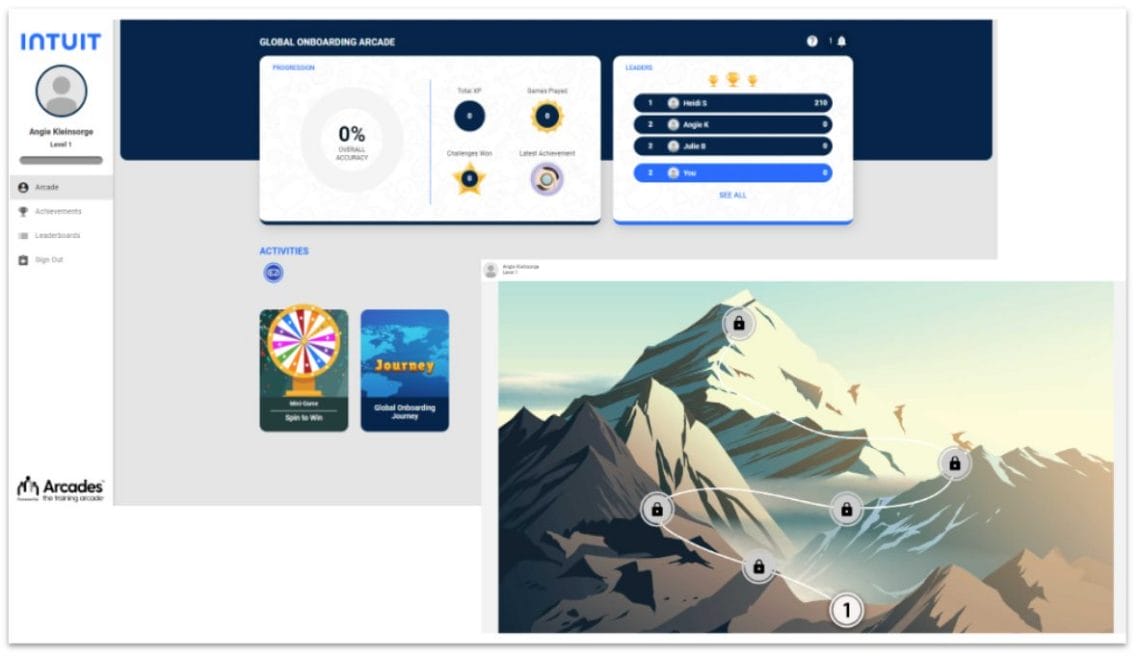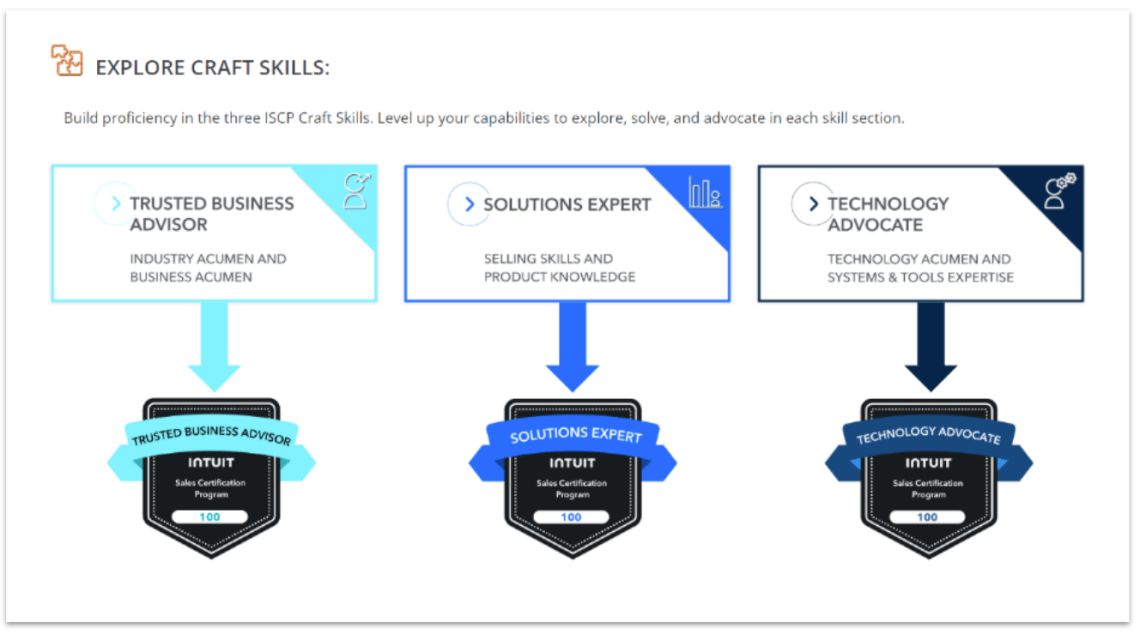 Some things are better together. Wine and cheese. Peanut butter and jelly. ELB Learning and Docebo…
Some things are better together. Wine and cheese. Peanut butter and jelly. ELB Learning and Docebo…
Ok, so that last one might sound a bit random, but if you ask the L&D team at Intuit (one of the world’s leading financial software providers), they’ll tell you it’s a winning combination.
In a recent webinar led by Andrew Scivally (Co-founder and CEO, ELB Learning) and Alessio Artuffo (President & COO, Docebo), Vanessa Valenzuela, Angie Kleinsorge, and Emily Hopkins shared how partnering with Docebo and ELB Learning enabled them to create transformative learning experiences that meaningfully engage their employees and customers (while keeping up with their organization’s needs). They also revealed three key learning trends that contributed to the program’s success.
You can watch the webinar recording for the full story, or read on to get the scoop.
Trend #1: It pays to personalize!
Your customers, partners, and employees are people. And just like each person has a unique set of fingerprints, they also each have a unique learning style.
What works for one person won’t work for another. (Even if they’re both employees in the same role or customers from the same company.) That’s what makes personalization so critical. As Alessio says, “When the power of good content meets the power of a good personalized platform, the end users reap the best benefits.”
When organizations use data-driven solutions and tools to consistently and repeatedly personalize the path and pace of their employees’ and customers’ learning experiences, they’re employing highly adaptive learning.
Why is that so important? Well, take a look at what embracing adaptive learning can do:
- Organizations focused on higher adaptive learning are 53% more likely to have experienced growth during the last year
- Adaptive learning organizations have a 13% better employee experience, including productivity and culture, two key challenges at any workplace!
- High-performing organizations have 1.5x higher adoption of methods that create highly personalized learning experiences than low-performing ones
So, how does an organization become highly adaptive? Check out these strategies that Intuit used to personalize its learning program.
Show that you know
When learners take a course, they’re telling you part of their story. They’re giving you valuable data about what they’re interested in and want to know more about. Don’t let this information go to waste! An organization’s learning platform should remember what the learners have learned and use this data to build a customized pathway to their goals and, ultimately, better learning experiences.
How Intuit made this happen
“We are really taking a skills-based approach to how we train,” says Vanessa Valenzuela, Group Manager of L&D at Intuit. “That learning path [at Intuit] is tied to the skills you need to take, and when you complete that learning path, those skills are written into your profile.”
 Personalized training landing pages
Personalized training landing pages
What’s especially cool about this approach is that Intuit was able to create a proof-of-concept where prospective learners could report what skills they already had. Based on that information, their learning paths were personalized to focus solely on building new skills.
Even the learners’ dashboards were personalized (based on the choices they’d made), so they would see only what’s relevant to them. As Angie Kleinsorge, Intuit’s Manager of L&D, says, “Our learners’ time is valuable, and they don’t want to waste time trying to find training. They just want to get in and get out.”
Show up where they work
Studies show that digital employees can spend up to four hours a week toggling between applications. (That’s a lot of wasted time!) Not only is this context switching a terrible user experience, but it also chews away at an employee’s efficiency.
As Vanessa shared, “We found that once employees are in the tools they use day to day, training isn’t top of mind anymore.” Rather than make employees switch between their CRM and training tools, Intuit decided to enable employees to work and learn in the same tool.
How Intuit pulled it off
With Docebo’s help, Intuit was able to seamlessly integrate training into their CRM. Personalized learning plans and courses now appear on the home page of the CRM. When an employee clicks on the learning content, it launches directly within the tool.

Embedding training in the flow of work
No toggling between applications. No searching for content. No interrupting the flow of work. This takes personalization to a whole new level by surfacing what employees need, when they need it, where they need it.
Show them “the yellow brick road”
Consider that, as learners have different learning styles, they also have different learning needs. This can be a challenge when trying to create a consistent learning experience that everyone can use. That’s where visual design comes in. Using visual elements makes pages easy to scan and creates a clear path for learners—a “yellow brick road”, as Vanessa says!
How Intuit paved the way
Intuit uses icons and color coding to create a clear and easy-to-navigate learning path. As Emily Hopkins, Manager, Learning Technology explains, “We leaned heavily into graphics and icons because we know they’re easier to comprehend. They also meet a broad swath of the audience that may not be reading the same language or have different accessibility barriers.”

Guiding learners with visual elements
Navigating via a color-coded or specific icon makes it easy for learners to stay on the right path.
Trend #2: Gamified experiences for the win
People like games. (Just try to find someone who doesn’t have one on their phone.) They find them engaging. So if this concept works so well outside of working hours, why not employ it during?
Gamification doesn’t mean crushing candy and shooting zombies instead of working—it means more motivated, more engaged, and happier employees. Still skeptical? There’s tons of research to back this up. Studies show:
- Learners are 55% more motivated to complete training when gamified elements are added
- There’s a 39% decrease in boredom when gamification elements are added to training
- And—here’s the big one—about 88% of employees are happier when training is gamified. That’s a huge increase. (Free pizza lunches may have a hard time topping that one!)
If you’re wondering what gamification looks like in action, here’s how Intuit has incorporated gamification into their learning strategy:
- Sales employees can engage in mock sales conversations with potential customers. Just like roleplaying games offer immediate success/fail responses to player decisions, learners get in-the-moment feedback they can apply when the real deal happens.
- Employees can sharpen their logic and reasoning skills (to prepare for tough customer conversations) by figuring out whodunnit with a detective-style game.
- Gamification is also going to become an integral part of the onboarding process. “Our intention there is to really engage our learners within the first ninety days,” says Angie.

Adding gamification to the onboarding experience
Given the success they’ve seen, they’re planning on rolling out more gamified training by integrating ELB Learning’s Training Arcade with their Docebo platform (see more about how Training Arcade works with Docebo in this video). This winning (pun intended) combination gives Intuit the scalable solution they need to deliver personalized gamified training that makes an impact.
Trend #3: A fixation on certification
Which brings us to our third trend: Certifications.
Certifications are good for business. Consider these stats:
- Every certified employee brings in $10K ($10K!) in added value.
- Certified employees are 72% more efficient and 71% more productive overall.
These numbers seem too good to be true! But, consider the motivational power of certification—that gold star, that green checkmark. As Alessio points out, “People really enjoy getting certified, because it feels like the knowledge that has been transferred during onboarding is reflected into a tangible outcome.”
Incredible credibility, inside and out
So it should be no surprise to hear that certification is another area where Intuit is shining! To start, they offer certification on two fronts:
On the external side
Through Intuit Academy, prospective employees have a pathway to becoming an Intuit expert. If someone gets hired, any skills they obtain are integrated into a personalized profile for the internal learning program.
“The programs provide you badges, but more importantly they’re providing you with skills in specific domains,” says Vanessa. “Our goal from here is to power prosperity for these people so we can get them a job here at Intuit as a live expert.”
On the internal side
Intuit’s sales team certainly won’t feel bored or undervalued thanks to their internal sales certification program, with customized content and assessments targeting skills at multiple levels.
 Sales certificates for Intuit employees
Sales certificates for Intuit employees
Here’s another neat accomplishment: Intuit created a customized integration with Docebo and their own assessment tool. Not only does it allow the learner to access everything through Docebo, it also works intelligently with Intuit’s assessment tool, sending data back and forth to keep track of the learner’s progress.
And what good is a course without an official designation of a successful effort? Naturally, when a learner completes an assessment, they get a badge (awarded through Credly) for each skill assessment passed that can be proudly displayed on their Facebook or LinkedIn page!
That feeling when a plan comes together
Before the revamp, Intuit was already well familiar with one trend; they had been trying to gamify their learning program for three years. But that approach resulted in a single experience on a single platform, for any and all learners. And, just like on family game night, not everyone wants to play the same game (Monopoly!) over and over.
Things changed for the better when they incorporated the other two trends:
- They introduced personalization so that different teams can try different games suited to their skills and roles.
- And they introduced certification by tying the gamified experiences to key business initiatives, another smart way to drive engagement!
“Skills change about every five years,” Angie explains. “We are three years into our certification program, so we are shifting and transforming to meet that new need and those new skills. With these changes, we are moving to personalized learning paths…and we will integrate gamification into the experience to enforce the knowledge and skill practice needed.”
It looks like we need to add personalization, gamification, and certification to that list of things that are better together.
How these trends transformed a learning experience
Through a focused personalization strategy, Intuit introduced a revamped learning experience that’s easier for their employees and customers to navigate, has a cleaner look and feel, and (of course) is customized to their learning goals and needs. And it’s paying off. As a result, Intuit has improved learner experience scores across all courses in their learning program!
Adding gamification elements, Intuit saw an immediate impact in the performance of their learners. Learners consistently engaged in gamification were more likely to be in the top performance quartile and less likely in the bottom, showing a 3% increase in business acumen, a 4% increase in technical acumen, and a whopping 14% increase in sales acumen.
And finally, after introducing certifications, professional development among Intuit employees skyrocketed. Certifications also provide a clear symbol of Intuit’s expertise to their customers—even a badge appearing on one of their experts’ social media pages can be enough to attract new prospects!
Let’s summarize: Three trends to try
So, if you’re wondering how to revitalize learner engagement in your organization, try this winning combination of trends:
- Personalization: Customize each learner’s experience to their skills, interests, goals, and needs. The more relevant the experience is, the more they’ll want to learn.
- Gamification: Weave game design principles (and even game play) into training to make learning fun (yes, fun!) and boost learner happiness.
- Certification: Validate skills, enhance credibility, boost career opportunities, and demonstrate commitment to your learners’ professional growth with certifications. Bonus: In addition to being good for your people, it’s also good for your business.
There’s more to this success story!
Through its all-star teamwork with Docebo and ELB Learning, Intuit unleashed the full potential of its learning program. Get all the details by watching the complete recording of the one-hour webinar, Creating Transformative Learning Experiences: An Intuit Success Story.
